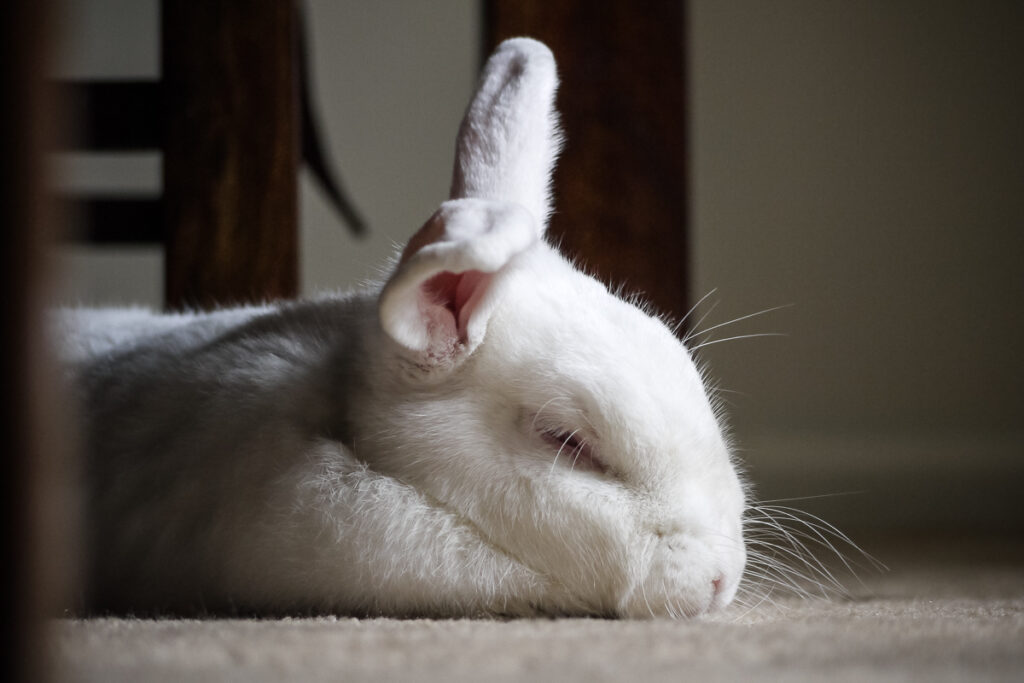THE MOST COMMON diseases of rabbits include digestive system problems, respiratory infections, and skin disorders.1 We’ve summarized the causes and treatments of these and several other common rabbit health problems below.
All information is intended as a general guide and is not intended to diagnose or treat your rabbit.
Our materials are for educational purposes only and not to substitute for a veterinary consultation. If you suspect your rabbit has a medical issue, we encourage you to contact a rabbit-savvy vet for diagnosis and treatment.
Abscesses
An abscess is a localized swelling in the tissues caused by an accumulation of pus, which is composed mostly of dead white blood cells and the bacteria those noble cells have killed. These can occur almost anywhere in a rabbit’s body, and while the center of an abscess is filled mostly with dead cells, the outer margins are often seething with live bacteria being walled off in a fleshy capsule by the rabbit’s defense mechanisms.2
Learn more about abscesses in rabbits from WabbitWiki.
Animal Attacks
If your rabbit has been attacked by a dog, raccoon, or any other predatory animal, take him to a vet, even if you see no bite wounds. These are sometimes unobservable without a veterinary exam. Also, a bunny might experience shock that may not be apparent for several hours. Precautionary treatment for shock is advisable anytime a rabbit has been subjected to an attack.3
Bladder sludge/stones
Bladder sludge, also known as hypercalcinuria or hypercalciuria in rabbits, is a thickening of the urine with calcium salts (usually calcium oxalate and calcium carbonate).4 Sludgy urine is also called cystitis. These crystals can also condense to form stones, or uroliths, in the bladder, urethra, ureters (duct by which urine passes from the kidney to the bladder), or renal pelvis (tube through which urine flows from the kidney to the urinary bladder).4 6
Learn more from WabbitWiki.
Bleeding Toenails
When toenails grow too long, they can break off and bleed. This may not require rushing off to the vet, but it does require adequate cleaning with a disinfectant. You can apply styptic powder or cornstarch to stop the bleeding. Keep bunny confined on a clean surface until the bleeding has stopped. If bone is exposed, antibiotics might be required to prevent infection. Contact your veterinarian for treatment and prescription.7
This video from Amy Sedaris and Mary Cotter provides excellent advice on nail trimming to avoid bleeding and broken toenails.
Broken Bones
While many fractures show immediate symptoms (e.g. dragging one foot), others may not be so obvious. If the rabbit has suffered trauma and or is favoring one limb, X-rays by a qualified veterinarian are needed to determine the extent of the injury.8
Learn more about broken bones in rabbits from WabbitWiki.
Conjunctivitis (Weepy Eye)
Rabbit conjunctivitis is often also known as weepy eye or pink eye. Signs are redness and swelling of the conjunctival membranes around the eye. The treatment consist of antibiotics drops as well as oral antibiotics and painkillers.9 We have an entire articles on chronic runny eyes and on sniffles and snot and other facial discharge, as well as a Complete Eye Guide.
Dental Disease
If your bunny is drooling or has chronic conjunctivitis, facial swelling, and seemingly decreased appetite, get a thorough dental exam, even if the incisors look fine to you. There may be molar spurs, tooth rot infections, or overgrown roots that penetrate the jawbone and, in some cases, may cause narrowing of the nasolacrimal ducts.10 We have an in-depth article on Teeth and Dental Diseases.
Diarrhea, Constipation, Bloat
These are often signs of a gastrointestinal disorder. This is a very serious condition that can become fatal quickly. Keeping an eye on your bunny’s behavior can help figure out how urgently they need to see the vet.
If your bunny is dealing with diarrhea, a low temperature, and appears lethargic, acting quickly is crucial. Warm them up and head to the pet hospital without delay.
If he is not pooping, bloated (tight belly), and sitting in a tense position or grinding his teeth, listen to his abdomen. Too much or too few gut sounds are danger signs. Your bunny could have GI Stasis and most likely needs a same-day vet appointment.11
Additional digestive system references are available at WabbitWiki.
Ear Issues
Mites and Fleas are common issues for both ears and skin.
Additional references for ear maladies are available at WabbitWiki.
Eye Issues
Runny or weepy eyes are common and can become a chronic issue. There are many other common eye issues, covered in our Rabbit Eye Guide.
E. cuniculi (Encephalitozoon cuniculi)
E cuniculi (Ec) is a microscopic brain and kidney parasite that affects rabbits along with a small range of other species. Some rabbits can carry the parasite without ever becoming ill while others may show a range of symptoms.12
Typical signs of infection:13
- Head tilting to one side.
- Eyes may track side to side or up and down.
- Shuffling or weakness on one or both back legs – in some cases paralysis
- Uncontrollable spinning or rolling
- Unexplained changes including seizures, deafness, cataracts or behavioural changes
Head Tilt
Head tilt is often accompanied by a loss of balance and the bunny might continually flip or roll. A bacterial infection of the inner ear that affect’s bunny’s sense of balance is a common cause. Other causes include a parasitic disease in the brain or a stroke. No matter what the cause, a veterinary exam is needed to diagnose the cause and determine a treatment.
If you can’t get to the vet for a few hours, there are tips on keeping your rabbit comfortable until you can get professional medical help.
Heat Stress/Heat Stroke
Rabbits don’t sweat and they can easily become overheated. Signs are panting and a wet nose. It is helpful to keep plastic bottles full of frozen water nearby to place next to your bunny on warm days. If your rabbit becomes overheated, you can mist his ears with cool water and hand a wet towel across the end of your rabbit’s enclosure. Set up a fan closeby for evaporative cooling. Be sure to keep the cord away from your rabbit as it can be a chewing hazard.
Lumps and Bumps
No need to panic and rush immediately to the hospital if you spot a lump or bump on your bunny who’s still acting, eating, and pooping normally. But do schedule an appointment to get it checked out fairly soon. Abscesses and tumors can be serious, and the right treatment depends on figuring out exactly what it is.
Megacolon
Megacolon is a genetic digestive condition that affects the function of a rabbit’s gastrointestinal (GI) tract in rabbits with certain genes. The condition is progressive and each rabbit may be affected differently, showing varying degrees of symptoms at different life stages.14
Learn more from Long Island Rabbit Rescue’s Megacolon Article and VGR1’s Megacolon page.
Mites & Fleas & other Skin Parasites
Symptoms of mites, fleas, and other skin diseases in rabbits include:
- itching, scratching, and restlessness
- fur loss, irritated or red skin, and redness
- Visible mites or fleas, especially around ears
- Ear inflammation, head shaking, and scratching
- Lack of appetite and weight loss
If you notice these symptoms, consult a vet promptly for accurate diagnosis and treatment.
Overgrooming
Overgrooming, also known as barbering, happens when a rabbit grooms himself or another rabbit so much that there is a bald spot or raw and irritated skin or ears. Common causes are stress, boredom, anxiety, allergies, or underlying medical conditions like dental problems, pain, or mites.
Paralysis
Partial or complete paralysis can have many diverse causes. Besides trauma to the head or back, causes may include strokes, tumors, bacterial or protozoan infections (such a e. cuniculi), viruses, nematodes, toxins, degenerative disease, congenital deformities, and even osteoporosis and arthritis.15
Red Urine
The color of rabbit urine can vary considerably. It can range from a light yellow with white sediment, to shades of orange, brown, and even a deep red that may be wrongly assumed to be blood.
Learn more from Long Island Rabbit Rescue’s Urine Article.
Respiratory Disease & Snuffles
Notable symptoms include nasal discharge or persistent sneezing, accompanied by rattling or labored breathing characterized by prolonged, intense breaths—distinct from the usual short panting in rabbits. While allergic reactions to bedding or dust may explain these signs, they could also indicate a chronic condition or the onset of a potentially life-threatening disease. Seeking prompt consultation with a qualified rabbit veterinarian is strongly advised.
Urine Scald
Urine scald may be an indication of urinary disease, but more often is a secondary problem in crippled or arthritic rabbits who urinate on themselves. Skin constantly exposed to urine becomes inflamed.16 17
Our Assisted Living article has many helpful suggestions.
Wounds (Cuts and Lacerations)
When your bunny gets cuts or scratches, it lets the germs on their skin sneak into the deeper layers, which can lead to infections. Always have a bottle of wound disinfectant on hand in your first aid kit and use it ASAP if you notice a skin wound. Follow up with triple antibiotic ointment such as Neosporin. Be sure to follow up and keep any cut, scratch, laceration, or other wound clean. It is also important to check it daily for swelling until fully healed. Deep cuts, punctures, or large wounds should be treated and monitored by your veterinarian.
Wounds can easily lead to abscesses so if in doubt, consult your veterinarian before treating.
Online Rabbit Health Groups and Forums
Joining online forums and support groups for rabbit caregivers can offer valuable tips for your bunny’s well-being and provide you with a supportive community.
- Exotic Vet Corners Educational Group (Facebook group)
- Rabbits Online
- EtherBun
- Disabled Rabbits.com
- Rabbits United Forum (UK)
References
- Disorders and Diseases of Rabbits, by Dr Diane McClure. Retrieved 12/28/23 from Merck Vet Manual https://www.merckvetmanual.com/all-other-pets/rabbits/disorders-and-diseases-of-rabbits ↩︎
- Head Abscesses in Rabbits, by Dana Kremples. Retrieved 12/28/23 from https://hare.as.miami.edu/jawabscess.html ↩︎
- House Rabbit Handbook 5th edition, p74. ↩︎
- Oglesbee, B. (2011). Blackwell’s five-minute veterinary consult: Small mammal. (2nd ed.). ↩︎
- Oglesbee, B. (2011). Blackwell’s five-minute veterinary consult: Small mammal. (2nd ed.). ↩︎
- Bladder sludge and stones, retrieved 12/28/2023 from WabbitWiki https://wabbitwiki.com/wiki/Bladder_sludge_and_stones ↩︎
- House Rabbit Handbook 5th edition, p74. ↩︎
- House Rabbit Handbook 5th edition, p74. ↩︎
- My House Rabbit, Julien Poublon, DVM MRCVS, Conjunctivitis in Young Rabbits ↩︎
- House Rabbit Handbook 5th edition, p75. ↩︎
- House Rabbit Handbook 5th edition, p75. ↩︎
- Rabbit Welfare Association & Fund. Rabbits and e. Cuniculi ↩︎
- IBID. ↩︎
- Recognizing and Managing Megacolon in Rabbits, by Long Island Rabbit Rescue. ↩︎
- House Rabbit Handbook 5th edition, p76. ↩︎
- House Rabbit Handbook 5th edition, p78. ↩︎
- Krempels, Dana. Urine Scald: A Symptom of a Greater Problem. ↩︎

